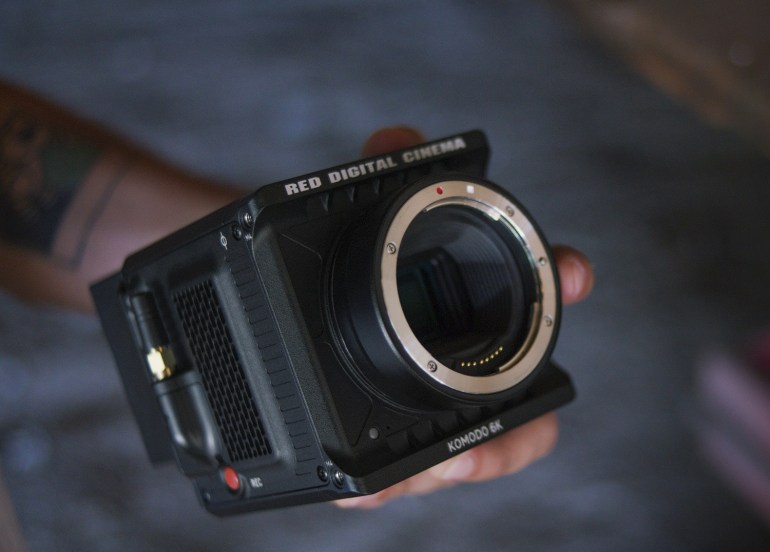RED Digital Cinema president Jarred Land gives IF the rundown of the new RED KOMODO 6K.
How was the KOMODO’s design conceived?
The original idea behind KOMODO was that it would be a utility camera used alongside our other cameras. It was designed for situations where our other cameras were either too big or, in crash situations, too expensive. We wanted KOMODO to be small, light, and tough and we needed a global shutter for those same situations – for fast moving subjects, fast moving cameras, flashes, and explosions.
One of the key features of the KOMODO is that it has a global shutter sensor. How do you believe filmmakers will benefit from this?
Global shutter indeed is one of the most important features of the KOMODO. Traditionally, cinema cameras have used rolling shutter sensors because global shutters came at the expense of dynamic range. Our sensor engineers were able to resolve that limitation and get the best of both worlds – a global shutter sensor with high dynamic range. A global shutter captures geometry much more accurately than rolling shutter sensors for fast moving images, since rolling shutters, as the name suggests, rolls capture through the sensor usually from top to bottom, line by line. The difference in time between the top row and bottom row happens at different narrow moments in time. This is why you see fence posts and streetlights appear to bend when you capture them from a moving car, and why you see split “flashes” when you capture explosions or camera flashes.
If you could define it, what distinguishes KOMODO footage? What projects call out for a KOMODO?
This answer has actually changed for me from development to now. As mentioned, KOMODO was conceived as a utility camera, a B cam or C cam or D cam for productions, but the incredible work from our product and engineering teams have put so much more into KOMODO than there was supposed to be. It has quickly moved into many A camera positions. Although KOMODO has only been shipping for a months, there have been a few features shot on it as an A camera, as well as many commercials, music videos etc.
The KOMODO has a Super35 sensor. However, the trend in digital cinema cameras at the moment is full frame. Talk me through this decision.
We still believe the same and are very invested in full frame. Apart from KOMODO, we make both sizes in our DSMC2 camera lineup, and we still see a pretty close ratio to the sensor size our customers chose. This is mostly an optics decision, as there is a tremendous amount of glass that exists that only covers S35, but that wasn’t the primary reason KOMODO is S35. KOMODO’s sensor size was dictated mostly by its mechanical physical size boundaries – our first implementation of AF pixels on a sensor as well as power requirements — but we have in no way abandoned the full frame format.

What has been some of the feedback you’ve received on the camera, especially now that it’s out there?
It has been quite the storm. We launched KOMODO during the first few months of the COVID-19 pandemic in limited, custom beta implementations. That was not just incredibly valuable for development but also a great community “distraction” to the world that everyone was painfully stuck in, and our customers are responding incredibly well to the images that the camera produces. I seem to be saying “special” a lot these days but that is the biggest feedback that we have received about the KOMODO. There is a lot of passion for it that I do not think I’ve seen since we released the first RED ONE.
RED is often credited with redefining digital cinema and thinking beyond film. How much of that spirit carries through with what you are developing today?
We appreciate that compliment but I like to think that we respectfully paid tribute to film more than we thought beyond it, at least in the early years of our company. Jim (Jannard) and I truly wanted to “do right” by film, and the 1080p low bitrate, low fidelity digital cameras that were itching to replace film before we showed up seemed a bit disrespectful to not only film and all the great years that film has given us, but also a bit disrespectful to the art of it all. We didn’t show up to put film in its grave. We showed up to earn its respect. I don’t honestly think we earned that respect until many years later and after many attempts. If film has finally retired, I think it would be proud of not just RED but all of the digital ecosystem and where it has evolved. RED as a company has changed tremendously over the last few years but I definitely think we still hold the same spirit that we started with in this company. We are still having fun, still putting customers and cameras first above all else, and still finding time to shoot as often as possible in-between.
RED KOMODO 6K FEATURES:
- 19.9 MP Super 35mm Global Shutter CMOS (27.03mm x 14.26mm)
- 16+ stops of dynamic range
- 101.6 mm form factor, weighing only 0.95 kgs
- Captures 6K at 40 fps, 6K WS at 50 fps, and 4K at 60 fps
- An RF mount to leverage adaptors for EF, PL and other lens systems, including anamorphic lenses
- A phase-detect based autofocus control on an integrated colour LED touchscreen display
- Streamlined REDCODE® RAW settings (HQ, MQ, and LQ compression options)
- Compatibility with CFAST 2.0 recording media
- 4K SDI output
- Built-in wireless capabilities and connectivity via the RED Control app
- Priced at $USD5,995


